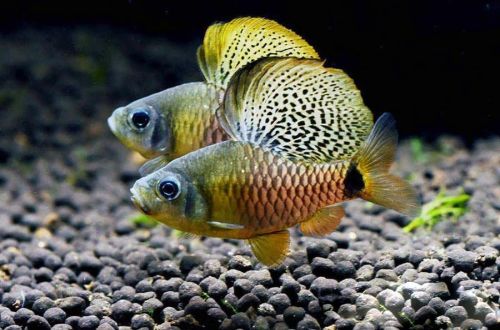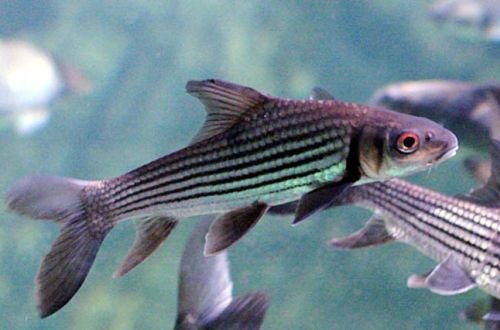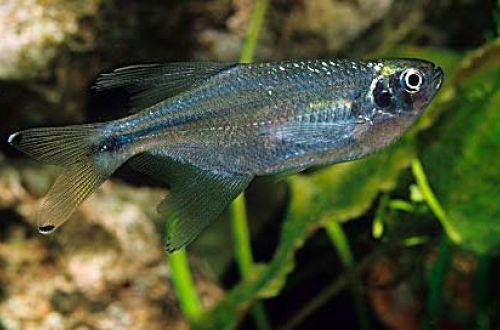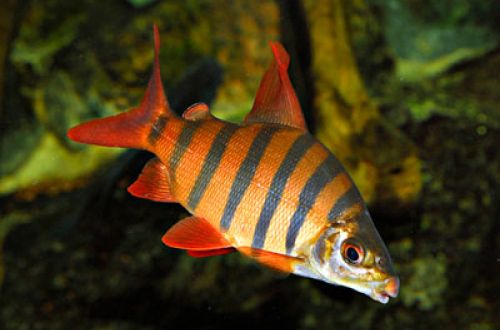
Barbus Oreichthys
Barbus Oreichthys, scientific name Oreichthys crenuchoides, belongs to the family Cyprinidae (Cyprinidae). An unusual representative of the Barbus family, largely due to the differences between female and male individuals. Males are brighter, larger and more showy than females. Fish are considered unpretentious and go well with other species. All this makes them a good choice for a freshwater aquarium.

Contents
Habitat
It originates from India and Bangladesh, where it is found mainly in the Brahmaputra river basin. The natural habitat is characterized by muddy substrates interspersed with sandbanks, an abundance of aquatic vegetation along the banks and numerous snags, the water is relatively clear, without a large amount of organic matter found in stagnant wetlands.
Brief information:
- The volume of the aquarium – from 60 liters.
- Temperature – 23-28°C
- Value pH — 6.0–7.0
- Water hardness – soft (1-10 dGH)
- Substrate type – soft sandy
- Lighting – subdued
- Brackish water – no
- Water movement is weak
- The size of the fish is about 4.5 cm.
- Feeding – any food of suitable size
- Temperament – peaceful
- Keeping in a group of 6-8 individuals
Description
Adult individuals reach a length of 3 to 4.5 cm. Unlike many other Barbs, this species has a pronounced sexual dimorphism. Males are larger and have a yellow-pink body color, at the base of the tail there is a black spot. Their main feature is a large dorsal fin, painted yellow with black speckles. In the state of spawning, males look most impressive: they open their dorsal fin, and the colors become more saturated. Females against their background may seem unremarkable. They are smaller, silvery in color with a dark spot near the tail and a black and yellow stroke on the dorsal fin.
Outwardly, it has much in common with the related species Barbus cozuatis, under whose name it is often erroneously presented for sale.
Food
They accept most popular foods (dry, live, frozen). It is worth noting that the coloring directly depends on the quality of the food they consume, so it is worth purchasing only high-quality feeds rich in all the necessary vitamins and trace elements, preferably enhancing the color. Products such as bloodworms or brine shrimp will not be superfluous.
Maintenance and care, arrangement of the aquarium
The optimal tank sizes for a small group of these fish start at 60 liters. In the design, it is recommended to use soft soil, dense thickets of plants, including floating ones, various snags and other shelters. The addition of dry tree leaves can give the aquarium a more natural look, characteristic of its natural habitat. In addition, dry leaves can affect the composition of water, more about this in the article “Which tree leaves can be used in an aquarium”.
Successful keeping depends largely on maintaining stable water conditions. To do this, it is necessary to carry out several mandatory procedures: weekly replacement of part of the water with fresh water, regular cleaning of the aquarium from organic waste, checking the basic parameters (pH, dGH, oxidizability, etc.), checking equipment operation, and so on. Depending on the equipment of the aquarium, the amount of work may be more or less.
When choosing a filtration system, it is worth giving preference to those filter models that do not cause excessive movement of water, since Barbus Oreichthys is not adapted to strong currents.
Behavior and Compatibility
A peaceful schooling fish, compatible with most other species of similar size and temperament. It is worth avoiding settling together with large and even more aggressive fish. It is preferable to keep at least 6-8 individuals in a flock. No intraspecific conflicts were observed. During the mating season, males may compete with each other for the attention of females, but this does not lead to skirmishes.
Females begin to show interesting behavior if kept separately from males. In one of them, within a couple of months, a typical large dorsal fin and coloration characteristic of males begin to form.
Fish diseases
In a balanced aquarium ecosystem with species-specific conditions, diseases rarely occur. Diseases are caused by environmental degradation, contact with sick fish, and injuries. If this could not be avoided, then more about the symptoms and methods of treatment in the section “Diseases of aquarium fish”.





